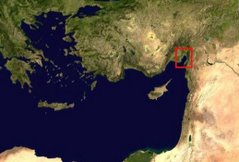Perhaps the most interesting find, however, was a few bitrified sherds, which have a yellowish sheen on their outer surface as a result of being overfired in the kiln. Now since this area of Cilicia was known in Roman times as a major center for pottery production, kiln sites have been a consideration in the back of our minds since we got here, so the discovery of these sherds was pretty exciting. In the same area we also found ceramic slag, which is overfired clay, so it definitely seems like we found an ancient kiln site on the top of this höyük.
We surveyed several other sites today as well, one of which had a huge white stone that legend says sits atop a pile of gold. It turns out this stone was part of an ancient olive press, so unless those infamous Cilician pirates and bandits buried their plunder under an old olive press, I’m not so optimistic about the veracity of this tale. For more on the olive press, you can check out Brandon Olson’s blog at http://historicalarchaeologyintheancientmediterranean.typepad.com. We met several locals who seemed very squeamish about letting us poke around too much, so our time at some of the sites was relatively brief. One of our local guides was even armed with a giant rifle, apparently for hunting wild boar in the hills and mountains.




2 comments:
Yikes. Be careful out there!
My Story I love your blog!
Post a Comment